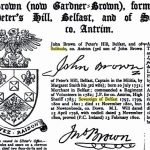House and home
The 140th birthday of Ireland’s Oldest Football Club seems like the perfect opportunity to revisit a story from last year regarding some recent discoveries about the origins of our famous home ground, Solitude.
Over the years, many stories have circulated about precisely where our home got its name – from the unkind 1960s jibes of low crowds to the more accurate surmisal that it was, in fact, named after a long-gone house that once stood in the vicinity.
Situated one mile from the edge of the town and derived from the name of an ancient tribal fort, the land in the area had been known as Solitude since at least 1785 when the property, which formed part of the Oldpark Estate, was acquired by a wealthy businessman – John Brown, High Sheriff of Antrim and the first Sovereign of Belfast. He built a house on the land and gave it the same name.
The precise location of the building has been the subject of much debate and disagreement in recent decades, with many under the mistaken (albeit somewhat romantic) impression that it was, in fact, what we now know as the Whitehouse pavilion within the stadium.
In reality, however, the truth lies a few hundred yards away.
Using the first Ordinance Survey map of Belfast from the 1830s overlaid on a more recent update, the location of ‘Solitude’ can clearly be seen, just to the right of the two islands in the top pond of the Waterworks.
What was a very substantial dwelling was later sold by a Mr Andrew Pinkerton in 1839 and subsequently demolished by the Belfast Water Commission to make way for an increase in the growing town’s water supply.
By the time Cliftonville Football Club’s ground was being developed on its present site some 50 years later in the late 1880s, the name ‘Solitude’ was still alive in locals’ memories and duly stuck when the Reds moved from their original home on the adjacent Cliftonville Cricket Pitch.
One of the oldest stadia in the world, Solitude remains the oldest football ground in Ireland and you can read the story of its fascinating history by clicking here.






